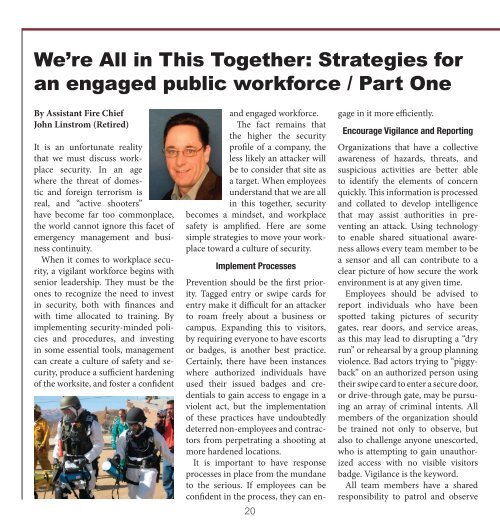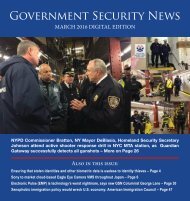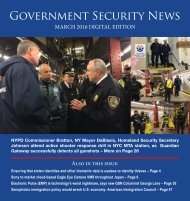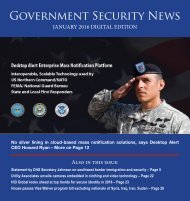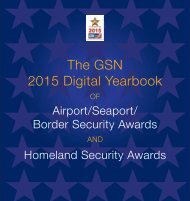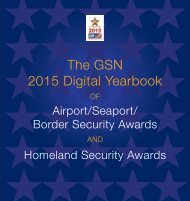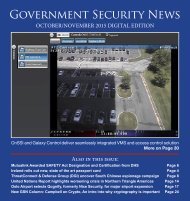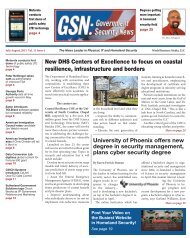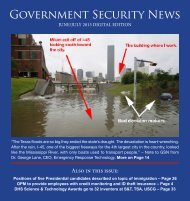GSN March 2016 Digital Edition
You also want an ePaper? Increase the reach of your titles
YUMPU automatically turns print PDFs into web optimized ePapers that Google loves.
We’re All in This Together: Strategies for<br />
an engaged public workforce / Part One<br />
By Assistant Fire Chief<br />
John Linstrom (Retired)<br />
It is an unfortunate reality<br />
that we must discuss workplace<br />
security. In an age<br />
where the threat of domestic<br />
and foreign terrorism is<br />
real, and “active shooters”<br />
have become far too commonplace,<br />
the world cannot ignore this facet of<br />
emergency management and business<br />
continuity.<br />
When it comes to workplace security,<br />
a vigilant workforce begins with<br />
senior leadership. They must be the<br />
ones to recognize the need to invest<br />
in security, both with finances and<br />
<br />
implementing security-minded policies<br />
and procedures, and investing<br />
in some essential tools, management<br />
can create a culture of safety and se-<br />
<br />
of the worksite, and foster a confident<br />
and engaged workforce.<br />
The fact remains that<br />
the higher the security<br />
profile of a company, the<br />
less likely an attacker will<br />
be to consider that site as<br />
a target. When employees<br />
understand that we are all<br />
in this together, security<br />
becomes a mindset, and workplace<br />
safety is amplified. Here are some<br />
simple strategies to move your workplace<br />
toward a culture of security.<br />
Implement Processes<br />
ity.<br />
Tagged entry or swipe cards for<br />
<br />
to roam freely about a business or<br />
campus. Expanding this to visitors,<br />
by requiring everyone to have escorts<br />
or badges, is another best practice.<br />
Certainly, there have been instances<br />
where authorized individuals have<br />
used their issued badges and credentials<br />
to gain access to engage in a<br />
violent act, but the implementation<br />
of these practices have undoubtedly<br />
deterred non-employees and contractors<br />
from perpetrating a shooting at<br />
more hardened locations.<br />
It is important to have response<br />
processes in place from the mundane<br />
to the serious. If employees can be<br />
confident in the process, they can en-<br />
20<br />
<br />
Encourage Vigilance and Reporting<br />
Organizations that have a collective<br />
awareness of hazards, threats, and<br />
suspicious activities are better able<br />
to identify the elements of concern<br />
quickly. This information is processed<br />
and collated to develop intelligence<br />
that may assist authorities in pre-<br />
<br />
to enable shared situational awareness<br />
allows every team member to be<br />
a sensor and all can contribute to a<br />
clear picture of how secure the work<br />
environment is at any given time.<br />
Employees should be advised to<br />
report individuals who have been<br />
spotted taking pictures of security<br />
gates, rear doors, and service areas,<br />
as this may lead to disrupting a “dry<br />
run” or rehearsal by a group planning<br />
<br />
back” on an authorized person using<br />
their swipe card to enter a secure door,<br />
or drive-through gate, may be pursuing<br />
an array of criminal intents. All<br />
members of the organization should<br />
be trained not only to observe, but<br />
also to challenge anyone unescorted,<br />
who is attempting to gain unauthorized<br />
access with no visible visitors<br />
badge. Vigilance is the keyword.<br />
All team members have a shared<br />
responsibility to patrol and observe


